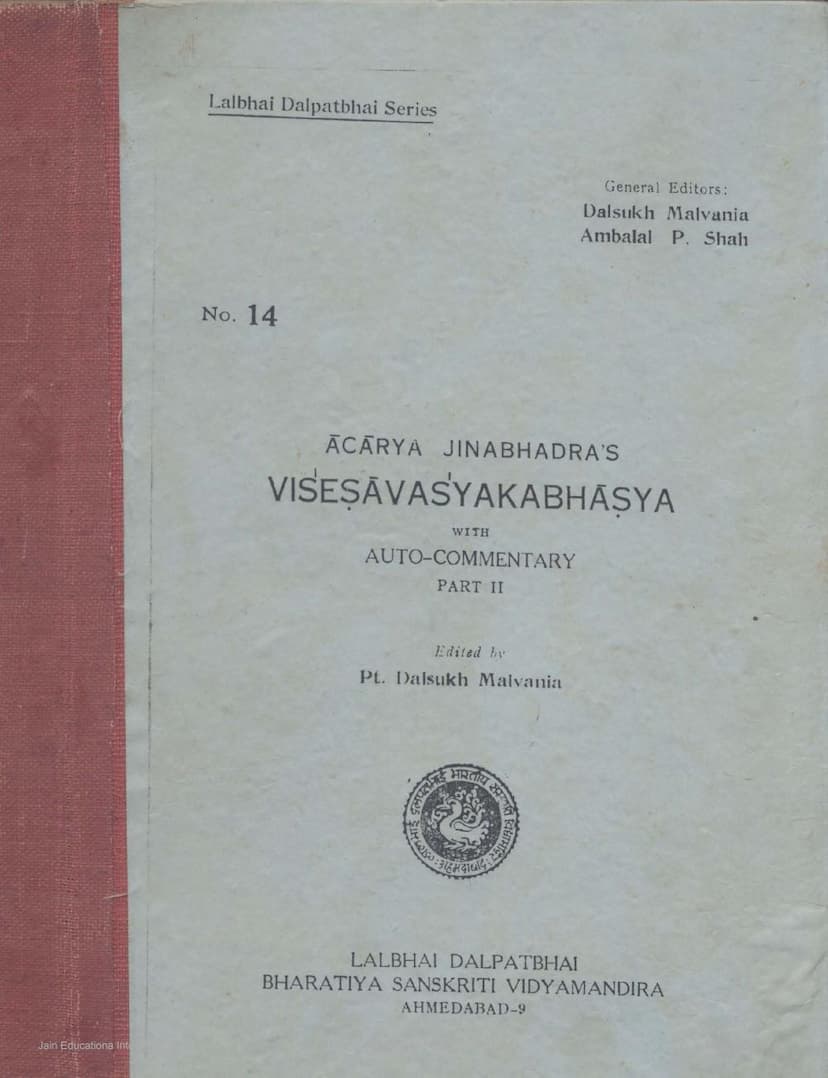Visesavasyakabhasya Part 2
Added to library: September 2, 2025

Summary
Based on the provided text, here is a comprehensive summary of the Visesavasyakabhasya Part 2:
Book Title: Visesavasyakabhasya Part 2 Author(s): Jinbhadrasuri, Dalsukh Malvania (Editor) Publisher: L D Indology Ahmedabad Series: Lalbhai Dalpatbhai Series No. 14
Overall Nature of the Text: This volume, Part II of Acarya Jinabhadra's Visesavasyakabhasya with his auto-commentary, is a highly detailed and complex Jain philosophical and scriptural work. It delves into various aspects of Jain doctrine, particularly focusing on the classifications (nikshepas), timelines, and explanations of key concepts and historical narratives within Jainism. The text is rich with philosophical arguments, refutations of opposing views, and detailed explanations of Jain cosmology and the lives of important figures.
Key Content Areas Covered in Part II:
-
Continuation of the Auto-Commentary: The auto-commentary by Acarya Jinabhadra concludes with gatha No. 2318, covering the chapter on the sixth ganadhara (chief disciple). This marks the end of Jinabhadra's direct commentary on the text.
-
Commentary by Kotaryavadi Gani: The volume includes the supplementary commentary by Kotaryavadi Gani, beginning from gatha No. 2319. This commentary serves to complete the work left unfinished by Jinabhadra, who reportedly passed away after completing the section on the sixth ganadhara. It's important to note that this commentary by Kotaryavadi Gani is distinct from another commentary by Kotyacharya previously published.
-
Key Philosophical and Doctrinal Topics: The text covers a wide array of subjects, including:
- Spiritual Life of Lord Mahavir: Discussions on the spiritual journey and teachings of Lord Mahavir.
- Discussions with Ganadharas: Lord Mahavir's dialogues with his ganadharas on various philosophical topics, such as the existence of the soul (jiva).
- Refutation of Nihnavas (Heretics/Opposing Views): The text engages in detailed refutations of various philosophical schools and viewpoints considered contrary to Jain doctrine. This includes discussions on:
- The existence of the soul (refuting nihilistic views).
- The concept of karma (its nature, bondage, liberation, and the refutation of views that deny it).
- The existence of God or deities.
- The nature of the soul and its relationship with the body.
- The reality of the afterlife and liberation.
- The refutation of voidism (shunyavada).
- The nature of cause and effect.
- The correct understanding of naya (standpoints) and pramana (means of knowledge).
- Nigama Dvara (Exclusion/Exiting): A significant portion of the text seems dedicated to the concept of Nigama in its various classifications (Dravya, Kshetra, Kala, Bhava, Purusha, Upakrama, Pratyaya, Lakshana, etc.), likely explaining how Jain principles exclude or differentiate themselves from other philosophies.
- Cyclical Time and Cosmic Cycles: Discussions on Utsarpini and Avasarpini (ascending and descending epochs of time) and their relevance to the creation and functioning of the universe.
- Genealogy and Lives of Tirthankaras and Royal Figures: The text provides detailed accounts of the lineage and lives of the Tirthankaras, including Rishabhadeva and Mahavir, as well as prominent kings like Bharata, Vasudeva, and Prativasudevas. It delves into their lifetimes, ascents to spiritual knowledge, and renunciations.
- The Concept of Time (Kala): Various interpretations and classifications of time, including Dravya Kala (substantive time) and Addhakala (momentary time), with detailed explanations of time units like Samaya, Avali, etc.
- The Nature of Nayas (Standpoints): A thorough exploration of the different Jain nayas (standpoints), such as Naigama, Sangraha, Vyavahara, Rigjusutra, Shabda, Samabhirudha, and Evambhuta, explaining their application and significance in understanding Jain reality.
- The Concept of Cause (Karana): A detailed analysis of the different types of causes according to Jain philosophy – Samavayi (inherent), Asamavayi (non-inherent), Nimitta (efficient), Pratyaya (contingent), and their various classifications.
- The Nature of Existence and Non-Existence: The text engages in arguments to establish the existence of Jain principles and refutes nihilistic viewpoints.
- The Concept of Moksha (Liberation): Discussions on the nature of liberation, its causes, and the path leading to it, likely through the lens of karma and its cessation.
- Refutation of Other Philosophical Systems: Implicitly and explicitly, the text critiques and refutes the doctrines of non-Jain philosophical schools through its detailed arguments and classifications.
-
Editorial and Publication Details:
- Editor: Pt. Dalsukh Malvania
- Publisher: Lalbhai Dalpatbhai Bharatiya Sanskriti Vidyamandira, Ahmedabad.
- First Edition: February 1968 (500 copies)
- Financial Support: Ministry of Education, Government of India.
- Price: Rupees Twenty.
Significance: Visesavasyakabhasya Part 2 is a monumental work in Jain literature, providing a deep dive into the complex philosophical framework of Jainism. It highlights the rigorous analytical methods employed by Jain scholars to defend and elucidate their doctrines. The inclusion of the auto-commentary and the supplementary commentary offers a multi-layered understanding of Acarya Jinabhadra's original work. The text is crucial for scholars of Indian philosophy, particularly Jainism, offering insights into its intricate logical structures and historical development.
Overall Impression from the Text Snippets: The provided pages reveal a highly scholastic and textual work. The detailed table of contents (विषयानुक्रमः) and the extensive chapter structure (indicated by "नि०" followed by numbers) suggest a systematic and comprehensive treatment of topics. The inclusion of Sanskrit and Prakrit terms, along with extensive commentary, underscores its academic and spiritual depth. The preface by the editor, Dalsukh Malvania, expresses gratitude to contributors and acknowledges the financial support, emphasizing the collaborative effort behind bringing this significant manuscript to light.